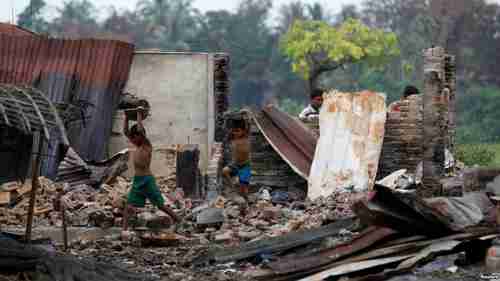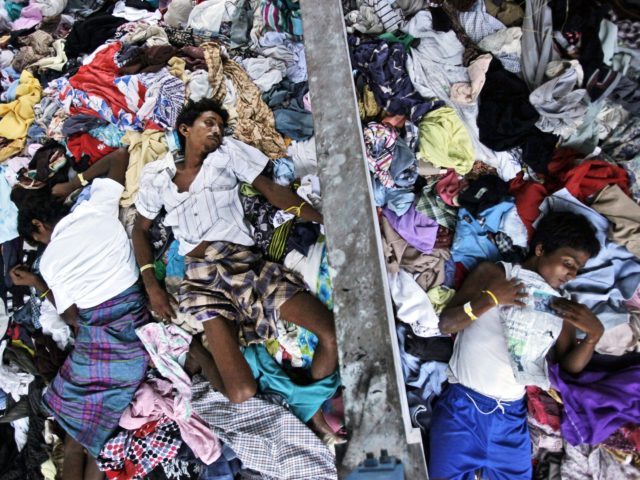This morning’s key headlines from GenerationalDynamics.com
- UN: Burma (Myanmar) committing ‘ethnic cleansing’ of Rohingyas
- Bangladesh is blocking Rohingya refugees fleeing from Burma violence
- Tens of thousands flee from northern Burma across border to China
UN: Burma (Myanmar) committing ‘ethnic cleansing’ of Rohingyas

Children recycle goods from the ruins of a market in a Rohingya village that was burned down two weeks ago (Reuters)
As we’ve been reporting, Human Rights Watch has posted satellite images that show that villages of Rohingya Muslims are being systematically burned down. Myanmar officials are making the laughable claim that the Rohingyas are burning down their own homes to embarrass the government, but it’s pretty widely believed that it’s being done Myanmar soldiers and security forces.
Myanmar officials are refusing to allow any aid agencies, international investigative agencies or reporters to enter the area to determine who is burning down the villages. However, eyewitness reports have been coming out, and John McKissick, head of the United Nations refugee agency (UNHCR) in the Bangladeshi border town of Cox’s Bazar, says that Myanmar troops are “killing men, shooting them, slaughtering children, raping women, burning and looting houses, forcing these people to cross the river” into Bangladesh. Other UN officials are saying that the Myanmar government actions are “ethnic cleansing.”
This is all completely believable in view of the history of the past few years. In 2012 and 2013, Buddhist monks in Burma have been leading genocidal attacks on Rohingyas, in violation of the precepts of the Buddhism religion. In one attack, large mobs with hundreds of Buddhists attacked Muslims with knives and sticks.
The attacks have been led by Buddhist monk Ashin Wirathu and his “969 movement,” where 969 is a historic Buddhist sign, referring to the nine qualities of Buddha, the six qualities of Buddha’s teaching, and nine qualities of the Buddhist community. 969 is supposed to promote peace and happiness, although Wirathu’s 969 movement is a vehicle promoting violence. And now the Burma’s army is apparently taking over the movement with ethnic cleansing.
From the point of view of Generational Dynamics, this is a classic, historical act of genocidal extermination of one group targeting another. In this generational Crisis era, we’re going to see more of these — Hindu vs Muslim in Kashmir, Sunni vs Shia in the Mideast, reminiscent of Hutus vs Tutsis in 1994 Rwanda, Christian vs Jew in World War II or French vs English in the Hundred Years War, or Protestant vs Catholic in European wars of the past. AFP and The Hindu and Al Jazeera
Related Articles
- Meiktila, Burma, violence has echoes of Kristallnacht (05-Apr-2013)
- Burma Buddhists attempt to justify genocidal attacks on Muslims (26-Jul-2013)
- Militants linked to Myanmar’s Rohingyas kill border guards in revenge attack (12-Oct-2016)
- Buddhist violence against Muslims in Burma/Myanmar continues to spread (03-Oct-2013)
Bangladesh is blocking Rohingya refugees fleeing from Burma violence
Thousands of desperate Rohingyas from Burma’s Rakhine state, threatened with ethnic cleansing by Burma’s soldiers, have been fleeing into Bangladesh in the past two weeks, either walking across the border or by boat across the Bay of Bengal.
However, Bangladesh has ignored international appeals, and is refusing them entry, and has turned boatloads of refugees back, forcing them to return to Burma. Bangladesh’s foreign ministry has confirmed that thousands of Rohingya have already sought refuge in the country, while thousands more are reportedly gathering on the border.
Those defending Bangladesh’s policy point out that there are millions of Rohingyas living in Rakhine state, and if Bangladesh completely opened the border, then the surge of fleeing refugees would be overwhelming. VOA and BBC and Al Jazeera
Related Articles
- U.N. alarmed as ethnic violence grows in western Burma (Myanmar) (27-Oct-2012)
- Burma (Myanmar) declares state of emergency over Buddhist/Muslim violence (11-Jun-2012)
Tens of thousands flee from northern Burma across border to China
Burma has a completely separate problem with other ethnic groups in the north – the Kachin Independence Army, the Ta’ang National Liberation Army, and Kokang’s Myanmar National Democratic Alliance Army. As I recently reported, these groups are continuing decades’ long fights with Burma’s army, and tens of thousands of residents from the region are fleeing across the border into China to escape the violence.
China has put its army on high alert along the border, and is reinforcing its troops on the border with military trucks, tanks, heavy weapons and machine guns. China says that it is willing to play a “constructive role” in helping Myanmar resolve the problem, but no one knows whether that would mean that under some circumstances China’s military would cross the border into Myanmar.
From the point of view of Generational Dynamics, Burma is an extremely difficult country to analyze because there are so many different ethnic groups fighting with and against each other. Following World War II, Burma experienced a series of extremely bloody crisis civil wars that only climaxed in 1958 when the army took over power. There has been sporadic fighting among these groups in the decades since then, but nothing that has escalated into a major war. Of the 15 armed ethnic groups in Burma, only eight were willing to sign a peace agreement at a recent signing ceremony.
A major research project is needed for Burma. The objective would be to analyze all Burma’s ethnic groups individually, and develop generational timelines for each of them. Any historian with knowledge or love of Burma will find this a rewarding project. Burma News International and CCTV (China) and VOA
Related Articles
- China puts army on high alert along border with Burma (Myanmar) (22-Nov-2016)
- Myanmar (Burma) government fails to conclude nationwide peace agreement (15-Oct-2015)
- Generational history of Burma (Myanmar) (26-Sep-2007)
KEYS: Generational Dynamics, Burma, Myanmar, Human Rights Watch, Rohingyas, John McKissick, Bangladesh, Ashin Wirathu, 969 movement, United Nations refugee agency, UNHCR, Kachin Independence Army, KIA, Ta’ang National Liberation Army, TNLA, Kokang’s Myanmar National Democratic Alliance Army, MNDAA
Permanent web link to this article
Receive daily World View columns by e-mail

COMMENTS
Please let us know if you're having issues with commenting.